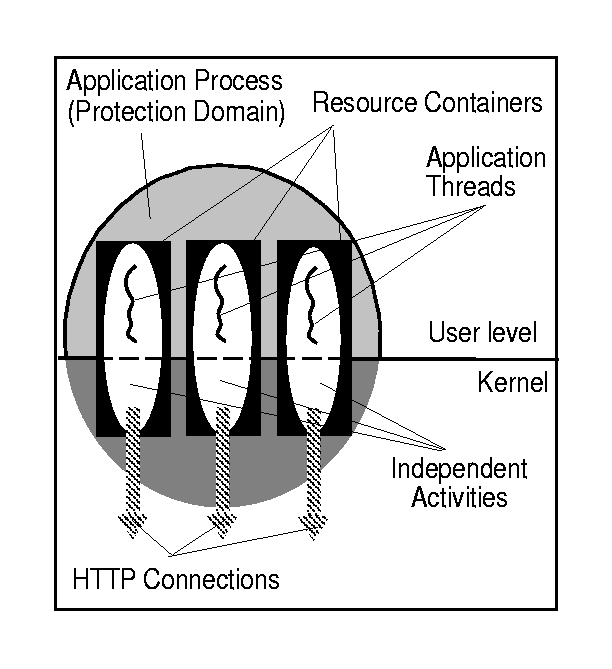 |

We now describe how a server application can use resource containers to provide robust and controlled behavior. We consider several example server designs.
First, consider a single-process multi-threaded Web server, that uses a dedicated kernel thread to handle each HTTP connection. The server creates a new resource container for each new connection, and assigns one of a pool of free threads to service the connection. The application sets the thread's resource binding to the container. Any subsequent kernel processing for this connection is charged to the connection's resource container. This situation is shown in Figure 9.
If a particular connection (for example, a long file transfer) consumes a lot of system resources, this consumption is charged to the resource container. As a result, the scheduling priority of the associated thread will decay, leading to the preferential scheduling of threads handling other connections.
Next, consider an event-driven server, on a uniprocessor, using a single kernel thread to handle all of its connections. Again, the server creates a new resource container for each new connection. When the server does processing for a given connection, it sets the thread's resource binding to that container. The operating system adds each such container to the thread's scheduler binding. Figure 10 depicts this situation.
If a connection consumes a lot of resources, this usage is charged to the corresponding container. The server application can obtain this usage information, and use it both to adjust the container's numeric priority, and to control how it subsequently expends its resources for the connection.
Both kinds of servers, when handling a request for a dynamic (CGI) document, pass the connection's container to the CGI process. This may either be done by inheritance, for traditional CGI using a child process, or explicitly, when persistent CGI server processes are used. (If the dynamic processing is done in a module within the server process itself, the application simply binds its thread to the appropriate container.)
A server may wish to assign different priorities to requests from different sources, even for processing that occurs in the kernel before the application sees the connection. This could be used to defend against some denial-of-service attacks, and could also be used by an ISP to provide an enhanced class of service to users who have paid a premium.
To support this prioritization, we define a new sockaddr namespace that includes a ``filter'' specifying a set of foreign addresses, in addition to the usual Internet address and port number. Filters are specified as tuples consisting of a template address and a CIDR network mask [36]. The application uses the bind() system call to bind multiple server sockets, each with the same<local-address, local-port> tuple but with a different<template-address, CIDR-mask> filter. The system uses these filters to assign requests from a particular client, or set of clients, to the socket with a matching filter. By associating a different resource container with each socket, the server application can assign different priorities to different sets of clients, prior to listening for and accepting new connections on these sockets. (One might also want to be able to specify complement filters, to accept connections except from certain clients.)
The server can use the resource container associated with a listening socket to set the priority of accepting new connections relative to servicing the existing ones. In particular, to defend against a denial-of-service attack from a specific set of clients, the server can create a socket whose filter matches this set, and then bind it to a resource container with a numeric priority of zero. (This requires the network infrastructure to reject spoofed source addresses, a problem currently being addressed [33].)
A server administrator may wish to restrict the total CPU consumption of certain classes of requests, such as CGI requests, requests from certain hosts, or requests for certain resources. The application can do this by creating a container for each such class, setting its attributes appropriately (e.g., limiting the total CPU usage of the class), and then creating the resource container for each individual request as the child of the corresponding class-specific container.
Because resource containers enable precise accounting for the costs of an activity, they may be useful to administrators simply for sending accurate bills to customers, and for use in capacity planning.
Resource containers are in some ways similar to many resource management mechanisms that have been developed in the context of multimedia and real-time operating systems [17,19,22,28,31]. Resource containers are distinguished from these other mechanism by their generality, and their direct applicability to existing general purpose operating systems. See Section 6 for more discussion of this related work.